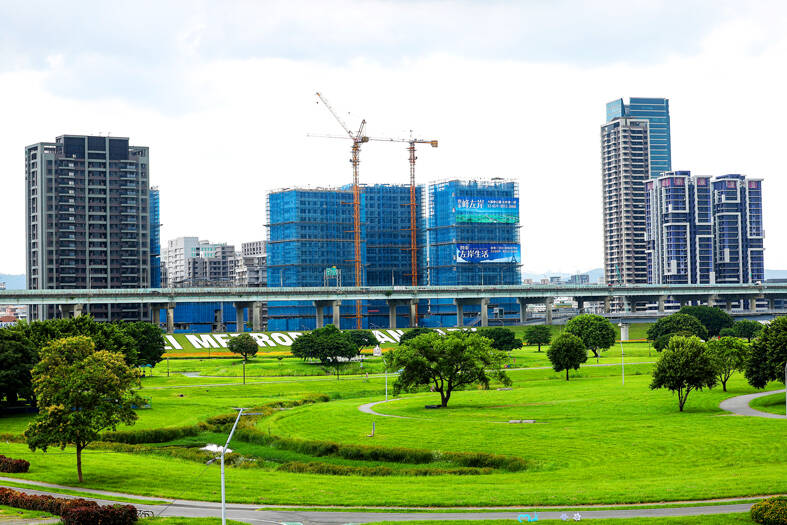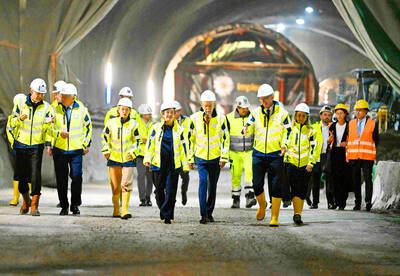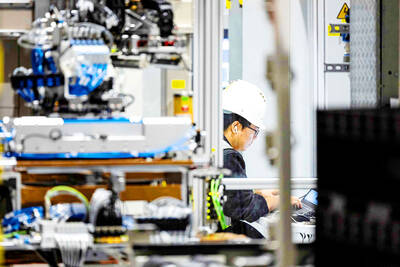Presale projects and new houses for sale in the coming fall sales season could exceed NT$200 billion (US$6.28 billion) in northern Taiwan, representing a 16.6 percent increase from the same time last year, as developers seek to cash in on preferential lending terms for first-home buyers, My Housing Monthly (住展雜誌) said yesterday.
The volume might hit NT$212.2 billion during this fall season, which would be the second highest in eight years, despite recent bans on transfers of presale house purchase agreements and an ongoing economic slowdown, it said.
The housing market has probably stabilized after digesting assorted unfavorable policy measures, the magazine’s research manager Chen Tsai-chi (成采錡) said.

Photo: CNA
Rather, the new preferential lending terms for first-home buyers, which keep interest rates on new mortgages at 1.775 percent, should be able to motivate people with real demand, Chen said.
Taipei would make the biggest contribution with presale projects and new houses sized at NT$78.8 billion, most being concentrated in Songshan District (松山) and Nangkang District (南港), the magazine said.
New Taipei City ranks second with NT$65.6 billion worth of new housing, it said, pointing out that Sanchong District (三重) alone underpins 60 percent, or about NT$40 billion.
The districts of Sinjhuang (新莊) and Tamsui (淡水) would make up NT$10 billion each, as the two locations gain popularity due to affordable house prices and improving infrastructure facilities, it said.
New housing at Taoyuan totals NT$45.8 billion with 50 percent of the projects located in Jhongli District (中壢), it found
The Hsinchu area is to see nearly NT$20 billion of presale projects and new houses that target people eyeing relatively large apartments, it said.
Keelung and Yilan would have NT$1.51 billion and NT$495 million of new housing aimed at local residents, it said.
The fall season starts on Sept. 28 and lasts through October.

CHIP RACE: Three years of overbroad export controls drove foreign competitors to pursue their own AI chips, and ‘cost US taxpayers billions of dollars,’ Nvidia said China has figured out the US strategy for allowing it to buy Nvidia Corp’s H200s and is rejecting the artificial intelligence (AI) chip in favor of domestically developed semiconductors, White House AI adviser David Sacks said, citing news reports. US President Donald Trump on Monday said that he would allow shipments of Nvidia’s H200 chips to China, part of an administration effort backed by Sacks to challenge Chinese tech champions such as Huawei Technologies Co (華為) by bringing US competition to their home market. On Friday, Sacks signaled that he was uncertain about whether that approach would work. “They’re rejecting our chips,” Sacks

NATIONAL SECURITY: Intel’s testing of ACM tools despite US government control ‘highlights egregious gaps in US technology protection policies,’ a former official said Chipmaker Intel Corp has tested chipmaking tools this year from a toolmaker with deep roots in China and two overseas units that were targeted by US sanctions, according to two sources with direct knowledge of the matter. Intel, which fended off calls for its CEO’s resignation from US President Donald Trump in August over his alleged ties to China, got the tools from ACM Research Inc, a Fremont, California-based producer of chipmaking equipment. Two of ACM’s units, based in Shanghai and South Korea, were among a number of firms barred last year from receiving US technology over claims they have

It is challenging to build infrastructure in much of Europe. Constrained budgets and polarized politics tend to undermine long-term projects, forcing officials to react to emergencies rather than plan for the future. Not in Austria. Today, the country is to officially open its Koralmbahn tunnel, the 5.9 billion euro (US$6.9 billion) centerpiece of a groundbreaking new railway that will eventually run from Poland’s Baltic coast to the Adriatic Sea, transforming travel within Austria and positioning the Alpine nation at the forefront of logistics in Europe. “It is Austria’s biggest socio-economic experiment in over a century,” said Eric Kirschner, an economist at Graz-based Joanneum

France is developing domestic production of electric vehicle (EV) batteries with an eye on industrial independence, but Asian experts are proving key in launching operations. In the Verkor factory outside the northern city of Dunkirk, which was inaugurated on Thursday, foreign specialists, notably from South Korea and Malaysia, are training the local staff. Verkor is the third battery gigafactory to open in northern France in a region that has become known as “Battery Valley.” At the Automotive Energy Supply Corp (AESC) factory near the city of Douai, where production has been under way for several months, Chinese engineers and technicians supervise French recruits. “They